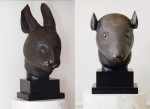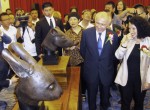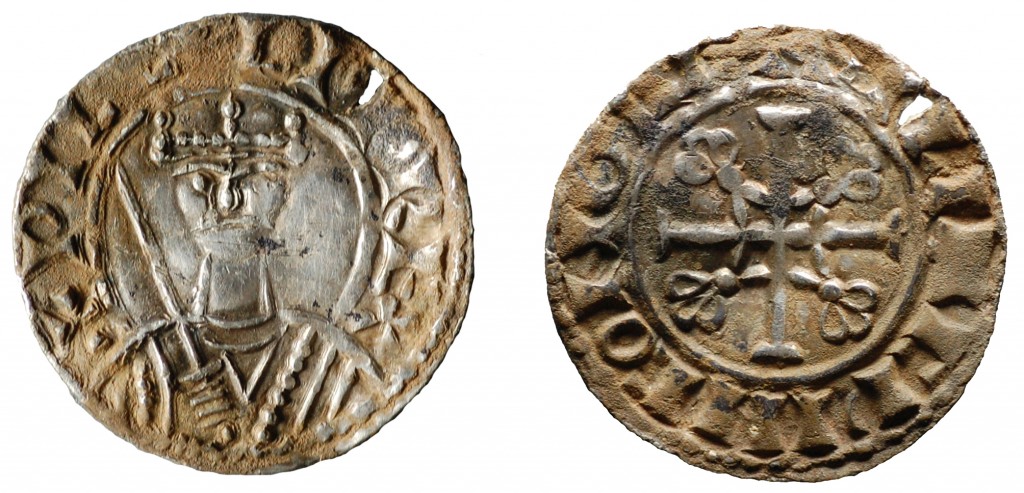I have happy endings to report for two stories: the Chinese bronze rat and rabbit heads and the William the Conqueror silver penny have all returned to their homes.
 The Chinese bronzes had the most eventful journey there and back again. They were part of a fountain clock built in 1759 on the grounds of the Old Summer Palace near Beijing. All 12 heads, representing the animals of the Chinese horoscope, were looted by Anglo-French troops when they sacked the palace in 1860 during the Second Opium War. The bronze heads became symbols of China’s humiliation at the hands of Western powers and the government has been keen to retrieve them. Five heads haven’t been seen since, while the others turned up over the years at various European auctions where all but two of them were secured either by the state-owned Poly Group or by wealthy collector Stanley Ho who donated them to Chinese museums.
The Chinese bronzes had the most eventful journey there and back again. They were part of a fountain clock built in 1759 on the grounds of the Old Summer Palace near Beijing. All 12 heads, representing the animals of the Chinese horoscope, were looted by Anglo-French troops when they sacked the palace in 1860 during the Second Opium War. The bronze heads became symbols of China’s humiliation at the hands of Western powers and the government has been keen to retrieve them. Five heads haven’t been seen since, while the others turned up over the years at various European auctions where all but two of them were secured either by the state-owned Poly Group or by wealthy collector Stanley Ho who donated them to Chinese museums.
The rat and the rabbit wound up in the insanely cluttered home of Yves Saint Laurent and his long-time companion Pierre Bergé. The latter attempted to sell them at a Christie’s auction in 2009 but controversy ensued and he wound up having to keep them. Somewhere between then and April of this year, François-Henri Pinault, billionaire CEO of Kering, the holding company that owns many luxury brands including Christie’s, bought the rat and rabbit. During a diplomatic visit to China attended by captains of French industry, Pinault announced that he would to return the bronze sculptures to China as a gesture of respect and friendship. He took pains to emphasize that this was a private gift from his family, not a repatriation from Christie’s, and said the official transfer would occur in the second half of this year.
 He didn’t waste any time. Less than two weeks after the half-year mark, on Friday, June 28th, 2013, François-Henri Pinault and his father François returned the statues to China in a ceremony at the National Museum of China in Tiananmen Square, Beijing. Chinese Vice Premier Liu Yandong and François Pinault lifted red velvet covers from the bronzes with a flourish and both sides exchanged flattery. Francois-Henri Pinault said:
He didn’t waste any time. Less than two weeks after the half-year mark, on Friday, June 28th, 2013, François-Henri Pinault and his father François returned the statues to China in a ceremony at the National Museum of China in Tiananmen Square, Beijing. Chinese Vice Premier Liu Yandong and François Pinault lifted red velvet covers from the bronzes with a flourish and both sides exchanged flattery. Francois-Henri Pinault said:
“This act represents the affection and respect of the Pinault family for the people of China. For my family it is above all a contribution to the promotion of art, and the preservation of an important cultural heritage. We always have the desire to accompany our enterprises with gestures and actions not necessarily economic or financial, but environmental or in the artistic domain. By returning these two marvels to China, my family is loyal to its commitment to preserving national heritage and artistic creation. They now return to their old home, Beijing.”
 Chinese Minister of Culture Li Xiaojie said: “This gesture is an expression of deep friendship with the Chinese people.” He thanked the Pinault family for this “act of respect for and protection of China’s cultural heritage” and expressed hope that it would encourage other wealthy businessmen desperate to curry favor with the Chinese government so as to get greater access to the country’s immense buying power to donate other objects of Chinese cultural heritage. Okay, that phrasing is mine rather than his, but there’s no question of what dog the Pinault family has in this rat and rabbit hunt. They sell luxury Western brands and the return of China’s dispersed patrimony is a point of pride for the nation and its rapidly embiggening moneyed class. The PR they’ve received for this gesture is of immense value in dollars and cents as well as in reputation.
Chinese Minister of Culture Li Xiaojie said: “This gesture is an expression of deep friendship with the Chinese people.” He thanked the Pinault family for this “act of respect for and protection of China’s cultural heritage” and expressed hope that it would encourage other wealthy businessmen desperate to curry favor with the Chinese government so as to get greater access to the country’s immense buying power to donate other objects of Chinese cultural heritage. Okay, that phrasing is mine rather than his, but there’s no question of what dog the Pinault family has in this rat and rabbit hunt. They sell luxury Western brands and the return of China’s dispersed patrimony is a point of pride for the nation and its rapidly embiggening moneyed class. The PR they’ve received for this gesture is of immense value in dollars and cents as well as in reputation.
(Not everyone is impressed, mind you. This article from People’s Daily quotes several people who dismiss the bronzes as relatively low-value targets. The National Museum of China deputy curator Chen Lyusheng describes them as “water faucets made by foreigners” which while dismissive is pretty much accurate since they were fountain water spouts and they were made by Italian Jesuit missionary Giuseppe Castiglione, aka Lang Shining.)
The bronze rat and rabbit will be on permanent display at the National Museum.

The City Museum and Art Gallery of Gloucester, England, will have a local treasure of its own on permanent display starting July 11th. The city council has purchased the William I silver penny discovered in November of 2011 by metal detector hobbyist Maureen Jones in a field just north of Gloucester. They paid a very reasonable £2,000 ($3,040) for a coin that is one of a kind and a testament to the importance of Gloucester in the Middle Ages.
The silver penny was minted by William the Conqueror’s moneyer Silacwine of Gloucester between 1077 and 1080. It’s the only coin ever discovered that was minted in Gloucester between those dates. The discovery fills in a blank in Gloucester history and underscores the importance of the city in William the Conqueror’s day.
Council leader Paul James said: “We are a city with 2,000 years of history. This is a significant find of major historical importance and plugs an historical gap in local knowledge.
“It proves that coins were being minted locally throughout the reign of William something that we haven’t been able to do until now.”